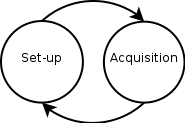Koch Lab:Publications/Drafts/Versatile Feedback/Software/High-Level Program Structure: Difference between revisions
(New page: ==Abstract== I will explain how we designed the data acquisition/feedback control software, by making an analogy to the functions of a digital camera. ==A Thought Experiment== How would ...) |
(→A Thought Experiment: outlined the rest of this example) |
||
| Line 4: | Line 4: | ||
==A Thought Experiment== | ==A Thought Experiment== | ||
How would you design a user interface for a digital camera? Using a camera has parallels in running an experiment: there is a set-up phase, where you compose the subject or scene and adjust the camera settings to obtain the desired effect, and then a data-acquisition phase, where the camera records the image. | How would you design a user interface for a digital camera? Using a camera has parallels in running an experiment: there is a set-up phase, where you compose the subject or scene and adjust the camera settings to obtain the desired effect, and then a data-acquisition phase, where the camera records the image. | ||
===Finite State Machines=== | |||
These phases can be diagrammed as a finite-state machine (FSM), such as the graph in figure 1. | |||
[[Image:FiniteStateMachine1.png]] | [[Image:FiniteStateMachine1.png]] | ||
| Line 13: | Line 16: | ||
LabVIEW programmers implement finite state machines by putting a Case structure inside a While Loop (or For Loop). At each iteration of the loop, some selector value determines the state (case) to run. | LabVIEW programmers implement finite state machines by putting a Case structure inside a While Loop (or For Loop). At each iteration of the loop, some selector value determines the state (case) to run. | ||
===Substructure of the Acquisition Phase=== | |||
===Our solution: a fixed structure, with the ability to run scripts=== | |||
==Hardware Limitations== | |||
Revision as of 23:41, 3 March 2008
Abstract
I will explain how we designed the data acquisition/feedback control software, by making an analogy to the functions of a digital camera.
A Thought Experiment
How would you design a user interface for a digital camera? Using a camera has parallels in running an experiment: there is a set-up phase, where you compose the subject or scene and adjust the camera settings to obtain the desired effect, and then a data-acquisition phase, where the camera records the image.
Finite State Machines
These phases can be diagrammed as a finite-state machine (FSM), such as the graph in figure 1.
Some cameras have multiple set-up phases: one for advanced settings (which cannot be interrupted for acquisition) and one for oft-changed settings (which can). Compare figure 2:
LabVIEW programmers implement finite state machines by putting a Case structure inside a While Loop (or For Loop). At each iteration of the loop, some selector value determines the state (case) to run.

